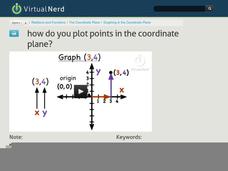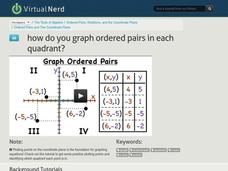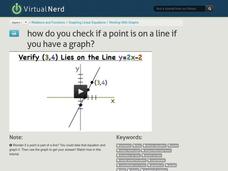Mathispower4u
Plotting Points on the Coordinate Plane
X and y mark the spot. Young scholars watch as a video instructor describes the process of plotting ordered pairs on a coordinate plane. Beginning with an overview of the vocabulary, the video demonstrates how to find the location of...
Mathispower4u
Plot Points Given as Ordered Pairs on the Coordinate Plane
You can't get from point A to point B if you can't find point A. Using a helpful video lesson, viewers learn how to plot points on a coordinate plane. The instructor emphasizes the vertical and horizontal distance of the x and...
Mathispower4u
Graphing Equations by Plotting Points - Part 1
It's not magic, it's math! Observe as a collection of points becomes a line. Scholars watch as a video instructor creates a table of values to graph linear equations. Examples include equations in both slope-intercept and standard forms.
Bozeman Science
Graphing Data By Hand
We have calculators, so why do we have to do this by hand? The video takes viewers through graphing scientific data by hand to create a scatter plot. The process includes labeling axes, writing an appropriate title, determining a...
Curated OER
How Do You Plot Points in the Coordinate Plane?
So you have an ordered pair and you want to graph it. Just remember that the first value is plotted along the x-axis and the second value in the pair is plotted along the y-axis. So count left or right, then up or down and you have...
Curated OER
Scatter Plots and Trends - Math Help
Introduce learners to the use and function of a scatter plot. Using the example of a how many traffic tickets a woman received in a ten year period, the tutor explains how to create the scatter plot, label the x and y axis, and plot...
Scholastic
Study Jams! Choosing the Correct Graph
With so many types of graphs, don't let your learners get stuck figuring out which one to use. To track how Zoe spent her allowance, use this interactive lesson to review all the types of graphs and pick the best one to display the data....
Mathispower4u
Graph a Direct Variation Equation (Negative Slope) Example 2
Bypass the table and go straight to the graph. A short video shows one example of graphing a direct variation equation with a negative slope by using the same method as graphing an equation in slope-intercept form. Pupils see it's easy...
Math Antics
Graphing on the Coordinate Plane
Graphing points is like painting a picture in algebra. Starting with a number line, the video constructs the coordinate plane. The presentation introduces the concept of a coordinate pair as an intersection of the two lines containing...
Curated OER
How Do You Graph a Horizontal Line?
Graph a horizontal line that goes through a given point by first plotting that point on a coordinate plane. Then draw a straight line left and right that goes through the point, and you're done!
Khan Academy
Example of Plotting a Simple Inequality on a Number Line, Pre-Algebra
Graphs are excellent tools for visualizing data. Use this video to demonstrate what inequalities look like on a number line. Sal draws a number line and shows the inequality. He effectively employs differentiated colors to express the...
Curated OER
How Do You Graph a Relation From a Table?
Just a couple of ways to look at some data regarding basketball free throw percentages for a specific player. Make a table and a coordinate axes graph. Plot the ordered pairs to get a nice visual to take a look at the data. Watch this...
Corbett Maths
Scatter Graphs
No scatter brains here—only graphs! A thorough video lesson begins by describing the process of plotting data to create a scatter plot. The instructor goes on to explain how to draw a line of best fit and then use it to make some...
FuseSchool
Completing the Square—Plotting Quadratics
Where is the turning point? The presentation demonstrates how the process of completing the square finds several points in the graph of a quadratic. One of the most important points found is the vertex of the graph. The video shows where...
Mathispower4u
Graph a Direct Variation Equation (Positive Slope) Example 1
Show classes a quick method to graphing. A short video demonstrates how to graph a direct variation equation by comparing it to graphing an equation in slope-intercept form. By seeing the y-intercept is 0, scholars easily plot the slope...
Curated OER
Find Zeros of a Function Given the Graph
Introduce zeros of a function and their relationship to the graph of the function. an informative video uses the definition of a zero to help identify them on a graph and provides several examples of finding the zeros of a...
Mathispower4u
Graph a Linear Equation in Slope-Intercept Form (Example 3)
The third example's the charm. Young mathematicians watch a helpful video that shows how to graph a linear equation in slope-intercept form on a coordinate plane. The narrator works through the example y = –2x + 5 by first plotting the...
Curated OER
How Do You Write an Equation of a Line in Slope-Intercept Form If You Have Two Points?
Given two points on a line, write an equation in slope-intercept form. But what's the slope? Oh, you have to figure out the slope first. That can be done given the two points. Just use the rise over run slope formula. This isn't so hard...
Curated OER
How Do You Check if a Point is on a Line If You Have a Graph?
The instructor demonstrates how to verify that a given point does or does not lie on the line of a given equation. She draws a graph (the axis lines need arrow ends) and plots the given linear equation. She then plots the coordinate...
Curated OER
How Do You Graph Ordered Pairs in Each Quadrant?
Draw a graph, label your units, make a table of your given coordinates. Now plot your points, label each point as you graph it. Next identify the quadrant that each point is in and add that to your table.
Curated OER
How Do You Graph Ordered Pairs in Each Quadrant?
Draw a graph, label your units, make a table of your given coordinates. Now plot your points, label each point as you graph it. Next identify the quadrant that each point is in and add that to your table.
Curated OER
How Do You Check if a Point is on a Line If You Have a Graph?
The instructor demonstrates graphically how to verify that a given point lies on the line of a given equation. She graphs a line in slope-intercept form, and then plots the point to verify if it is in fact, on the graph of the line.
Curated OER
How Do You Find the X-Coordinate of a Point on a Line If You Have Another Point and the Slope?
Use the slope formula to find the missing coordinate. You've been given all the needed information to solve this problem. So all you need to do is plug in the values and solve for the missing variable value.
Khan Academy
Graphs of Linear Equations, Linear Equations and Functions, 8th grade
Sal is plotting away in this video - but don't worry, it's nothing suspicious. He introduces linear equations, taking viewers through a few simple examples before applying the knowledge to more complex word problems.























